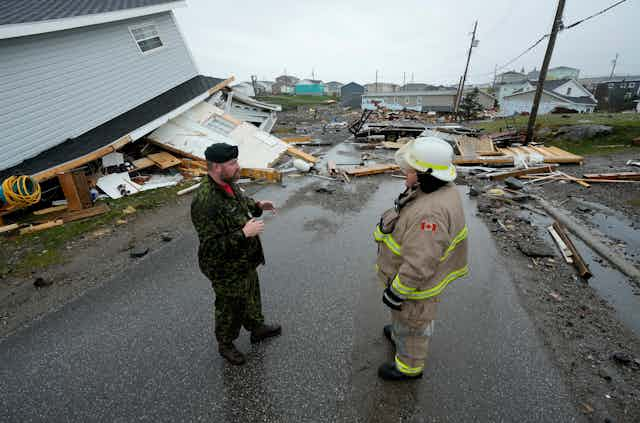Forty-eight hours after post-tropical cyclone Fiona’s devastating impacts on areas of Nova Scotia, Prince Edward Island, New Brunswick, Newfoundland and Labrador and Québec’s Magdalen Islands we can now start to reflect on the magnitude of what has just happened.
Over the coming weeks, there will be much to be analyzed as response shifts to recovery for what will become known as one of Canada’s worst natural disasters.
An early lesson we can take away from this disaster is that evacuation is critical. In this era of high intensity tropical cyclones which in part appear to be driven by climate change, the best disaster management option we have is to simply get out of their way.
While any disaster death is tragic, it is a minor miracle that at this point only three deaths have been attributed to this cyclone. One of the reasons for this low casualty count is the evacuations that occurred in advance of the storm’s arrival.
Intense damage
An area where some of the most intense damages occurred was the small coastal town of Channel-Port aux Basques in Newfoundland and Labrador. Wind-driven waves and storm surges rendered all existing protective measures, including shoreline barriers, as wholly ineffective.
It was reported that waves were coming into town with heights over 12 metres tall and probably breaking over 16 metres.
The day after the storm, the mayor said the damages to the town were much worse than first thought, with no trace left of many structures as they were swept out to sea.
In Channel-Port aux Basques, a 73-year-old woman who was in her home when the storm made landfall on Sept. 25 perished as she was swept out to sea. She was getting ready to evacuate when a wave came in and tore away a portion of the basement of her home, sweeping her into the maelstrom of the churning ocean.
At this time, the most important reality on the individual level is coping with the toll of this tragic death. The situation is especially tragic as the women killed was apparently in the process of evacuating.
Evacuation science
Disaster social science literature helps us to better understand factors which influence specific evacuation behaviours. Experts have studied multiple factors influencing evacuation behaviour to provide clarity on this complex social process.
Examples of areas of research on the intricacies of evacuation behaviour include: how storm-specific physical factors affect an individual’s decision to evacuate or not; how recommendations of protective actions from public officials like evacuation orders contribute to decisions to stay or go; how demographic factors — like age, gender or race — influence behaviour; and how seeking information contributes to decision making.

In the case of the fatality in Channel-Port aux Basques, what if the decision to take action to actually evacuate could have been made sooner?
Protective action initiation time is the lag between when warnings are issued and when people begin to actually take protective actions and evacuate. This is a critical period of time.
Factors such as the need for extra time to prepare, finding a destination to evacuate to, a person’s physical abilities and access to resources and requiring time to confirm the threat all contribute to the lag time.
The lag time between knowing one needs to evacuate and the actual leaving can be critical to whether one lives or dies when a cyclone’s storm surge is imminent.
Despite the many behavioural variables involved in evacuation decision-making, research has shown that how and when authorities issue evacuation orders has been found to be a primary triggering variable for timing in determining when residents leave. For example, communications like the Royal Canadian Mounted Police’s Public Advisory asking residents to obey evacuation orders were critical.
Mass casualties prevented
One lesson that post-tropical cyclone Fiona has shown us is that it will not be possible to mitigate our way out of extreme natural disasters driven by our warming climate. It is not possible to build taller seawalls across Atlantic Canada, protecting all vulnerable coastlines against excessively high waves. Neither is it feasible to armour all structures to withstand sustained winds in the range of 150 km per hr.
However, what can be done is when these very intense storms make landfall is to move out of the way by evacuating coastal zones in advance. In the case of post-tropical cyclone Fiona, evacuations of many coastal areas in small towns across Atlantic Canada prevented multiple mass casualty events.

